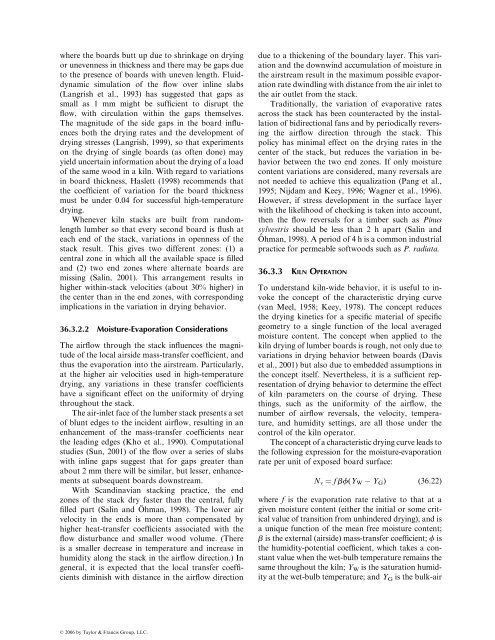36 Drying of Wood
36 Drying of Wood
36 Drying of Wood
- No tags were found...
You also want an ePaper? Increase the reach of your titles
YUMPU automatically turns print PDFs into web optimized ePapers that Google loves.
where the boards butt up due to shrinkage on dryingor unevenness in thickness and there may be gaps dueto the presence <strong>of</strong> boards with uneven length. Fluiddynamicsimulation <strong>of</strong> the flow over inline slabs(Langrish et al., 1993) has suggested that gaps assmall as 1 mm might be sufficient to disrupt theflow, with circulation within the gaps themselves.The magnitude <strong>of</strong> the side gaps in the board influencesboth the drying rates and the development <strong>of</strong>drying stresses (Langrish, 1999), so that experimentson the drying <strong>of</strong> single boards (as <strong>of</strong>ten done) mayyield uncertain information about the drying <strong>of</strong> a load<strong>of</strong> the same wood in a kiln. With regard to variationsin board thickness, Haslett (1998) recommends thatthe coefficient <strong>of</strong> variation for the board thicknessmust be under 0.04 for successful high-temperaturedrying.Whenever kiln stacks are built from randomlengthlumber so that every second board is flush ateach end <strong>of</strong> the stack, variations in openness <strong>of</strong> thestack result. This gives two different zones: (1) acentral zone in which all the available space is filledand (2) two end zones where alternate boards aremissing (Salin, 2001). This arrangement results inhigher within-stack velocities (about 30% higher) inthe center than in the end zones, with correspondingimplications in the variation in drying behavior.<strong>36</strong>.3.2.2 Moisture-Evaporation ConsiderationsThe airflow through the stack influences the magnitude<strong>of</strong> the local airside mass-transfer coefficient, andthus the evaporation into the airstream. Particularly,at the higher air velocities used in high-temperaturedrying, any variations in these transfer coefficientshave a significant effect on the uniformity <strong>of</strong> dryingthroughout the stack.The air-inlet face <strong>of</strong> the lumber stack presents a set<strong>of</strong> blunt edges to the incident airflow, resulting in anenhancement <strong>of</strong> the mass-transfer coefficients nearthe leading edges (Kho et al., 1990). Computationalstudies (Sun, 2001) <strong>of</strong> the flow over a series <strong>of</strong> slabswith inline gaps suggest that for gaps greater thanabout 2 mm there will be similar, but lesser, enhancementsat subsequent boards downstream.With Scandinavian stacking practice, the endzones <strong>of</strong> the stack dry faster than the central, fullyfilled part (Salin and Öhman, 1998). The lower airvelocity in the ends is more than compensated byhigher heat-transfer coefficients associated with theflow disturbance and smaller wood volume. (Thereis a smaller decrease in temperature and increase inhumidity along the stack in the airflow direction.) Ingeneral, it is expected that the local transfer coefficientsdiminish with distance in the airflow directiondue to a thickening <strong>of</strong> the boundary layer. This variationand the downwind accumulation <strong>of</strong> moisture inthe airstream result in the maximum possible evaporationrate dwindling with distance from the air inlet tothe air outlet from the stack.Traditionally, the variation <strong>of</strong> evaporative ratesacross the stack has been counteracted by the installation<strong>of</strong> bidirectional fans and by periodically reversingthe airflow direction through the stack. Thispolicy has minimal effect on the drying rates in thecenter <strong>of</strong> the stack, but reduces the variation in behaviorbetween the two end zones. If only moisturecontent variations are considered, many reversals arenot needed to achieve this equalization (Pang et al.,1995; Nijdam and Keey, 1996; Wagner et al., 1996).However, if stress development in the surface layerwith the likelihood <strong>of</strong> checking is taken into account,then the flow reversals for a timber such as Pinussylvestris should be less than 2 h apart (Salin andÖhman, 1998). A period <strong>of</strong> 4 h is a common industrialpractice for permeable s<strong>of</strong>twoods such as P. radiata.<strong>36</strong>.3.3 KILN OPERATIONTo understand kiln-wide behavior, it is useful to invokethe concept <strong>of</strong> the characteristic drying curve(van Meel, 1958; Keey, 1978). The concept reducesthe drying kinetics for a specific material <strong>of</strong> specificgeometry to a single function <strong>of</strong> the local averagedmoisture content. The concept when applied to thekiln drying <strong>of</strong> lumber boards is rough, not only due tovariations in drying behavior between boards (Daviset al., 2001) but also due to embedded assumptions inthe concept itself. Nevertheless, it is a sufficient representation<strong>of</strong> drying behavior to determine the effect<strong>of</strong> kiln parameters on the course <strong>of</strong> drying. Thesethings, such as the uniformity <strong>of</strong> the airflow, thenumber <strong>of</strong> airflow reversals, the velocity, temperature,and humidity settings, are all those under thecontrol <strong>of</strong> the kiln operator.The concept <strong>of</strong> a characteristic drying curve leads tothe following expression for the moisture-evaporationrate per unit <strong>of</strong> exposed board surface:N v ¼ f bf(Y W Y G ) (<strong>36</strong>:22)where f is the evaporation rate relative to that at agiven moisture content (either the initial or some criticalvalue <strong>of</strong> transition from unhindered drying), and isa unique function <strong>of</strong> the mean free moisture content;b is the external (airside) mass-transfer coefficient; f isthe humidity-potential coefficient, which takes a constantvalue when the wet-bulb temperature remains thesame throughout the kiln; Y W is the saturation humidityat the wet-bulb temperature; and Y G is the bulk-airß 2006 by Taylor & Francis Group, LLC.
















